List of German flags
This is a list of historic flags used by and in Germany. For more information about the current national flag, see Flag of Germany.
National flags
| Flag | Date | Use | Description |
 | 1919–1933;
since 1949 | National and merchant flag (Bundes- und Handelsflagge) | A tricolour, made of three equal horizontal bands coloured black (top), red, and gold (bottom). |
.svg.png) | 1950– | State flag and ensign (Bundesdienstflagge) and military flag (Kriegsflagge). This flag may only be used by federal government authorities. | The national flag with the Bundesschild (a variant of the coat of arms of Germany) in the centre. The flag was originally used 1921–1933 in the Weimar Republic. While identical in heraldic terms to the original Weimar era flag, the modern exact design is slightly simplified. |
.svg.png) | | National flag with coat of arms (Bundesflagge mit Bundeswappen). Unofficial version, the private use of which is not penalized. | |
.svg.png) | 1996– | Hanging national flag (Bannerflagge) | |
.svg.png) | 1996– | Hanging state flag | |
Presidential standard
| Flag | Date | Use | Description |
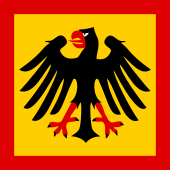 | 1921–1926;
since 1950 | Standard of the President of Germany | The standard depicts the elements of the coat of arms. A version of the standard that is identical in heraldic terms, but with a slightly different exact design, was used 1926–1933. |
Military and state flags
| Flag | Date | Use | Description |
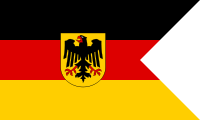 | 1956– | War ensign and naval jack (Seekriegsflagge und Gösch) of the German Navy | A swallowtail variant of the state flag |
 | 1957– | Standard of Inspector General of the Bundeswehr | |
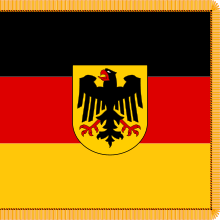 | 1964– | Troop colour (Truppenfahne) of the Bundeswehr | |
.svg.png) | 1950–1994 | Flag of Deutsche Bundespost | |
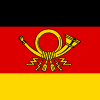 | 1950–1994 | Flag of the Minister of Deutsche Bundespost | |
 | 1950–1994 | Flag of the President of Deutsche Bundespost | A swallowtail variant of the postal flag |
 | 1950–1994 | Flag of the State Secretary of Deutsche Bundespost | |
Flags of German states
Civil flags
State flags
Historical flags
| Flag | Date | Use | Description |
.svg.png) | 1848–1865 | Flag of the German Confederation, used in 1848 and again in 1863-1866 | Also German Empire (1848/1849) |
.svg.png) | 1848–1852 | War ensign of the Reichsflotte | |
 | 1848–1852 | Marine jack of the Reichsflotte | |
| Flag | Date | Use | Description |
 | 1867–1871 | National and merchant flag (National- und Handelsflagge) | A tricolour, made of three equal horizontal bands coloured black (top), white, and red (bottom) |
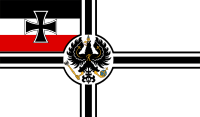 | 1867–1871 | War flag (Kriegsflagge) | |
.svg.png) | 1867–1871 | Marine jack (Kriegsschiffgösch) | |
| Flag | Date | Use | Description |
 | 1871–1918 | National and merchant flag (National- und Handelsflagge) | |
.svg.png) | 1896–1918 | Merchant flag variant with the Iron Cross (Eisernes Kreuz) | |
 | 1871–1892 | Imperial Navy war ensign (Kriegsflagge) | |
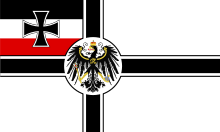 | 1892–1903 | Reich war flag (Reichskriegsflagge) | |
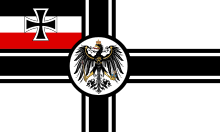 | 1903–1918 (1921) | Reich war flag | |
.svg.png) | 1871–1903 | Marine jack (Kriegsschiffgösch) | |
.svg.png) | 1903–1918 (1921) | Marine jack | |
Imperial family standards
| Flag | Date | Use | Description |
.svg.png) | 1919–1933 | National flag (Nationalflagge) | |
.svg.png) | 1921–1933 | State flag (Dienstflagge zu Land) | |
.svg.png) | 1919–1933 | Merchant flag (Handelsflagge) | |
.svg.png) | 1921–1933 | Merchant flag variant with the Iron Cross (Eisernes Kreuz) | |
.svg.png) | 1921–1926 | State ensign (Dienstflagge zur See) | |
 | 1926–1933 | State ensign (Dienstflagge zur See) | |
.svg.png) | 1919–1921 (de jure) | Reich war flag (Reichskriegsflagge) | |
.svg.png) | 1921–1933 | Reich war flag | |
.svg.png) | 1921–1933 | Marine jack (Kriegsgösch) | |
 | 1921–1926 | Standard of the President | |
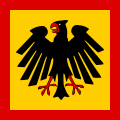 | 1926–1933 | Standard of the President | |
.svg.png) | 1919–1921 | Flag of the President | |
.svg.png) | 1919–1921 | Flag of Defence Minister | |
.svg.png) | 1921–1933 | Flag of Defence Minister | |
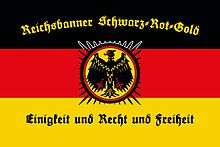 | 1924–1933;
since 1953 | Flag of the Reichsbanner Schwarz-Rot-Gold | The Reichsbanner Schwarz-Rot-Gold was an unofficial republican paramilitary organization dominated by social democrats, liberals, and members of the Catholic Centre Party, to defend the Weimar Republic against National Socialists, communists, and monarchists. Refounded in 1953 as an association for political education. |
The flag with the hakenkreuz and white disc centered was used throughout (1920–45) as the NSDAP party flag (Parteiflagge).[1] Between 1933 and 1935, it was used as the national flag (Nationalflagge) and merchant flag (Handelsflagge) - interchangeably with the black-white-red horizontal tricolour last used (up to 1918) by the German Empire. In 1935, the black-white-red horizontal tricolour was scrapped again, and the flag with the off-center swastika and disc was instituted as the only national flag (and was to remain as such until 1945). The flag with the centered disc only continued to be used as the Parteiflagge after 1935.
| Flag | Date | Use | Description |
| Flags used 1933 – 1935 |
.svg.png) |
- 1933–1935
- 1933–1935
- 1920–1945
|
- National flag (Nationalflagge)
- Merchant flag (Handelsflagge)
- NSDAP Party flag (Parteiflagge)[1]
|
A red field, with a white disc with a black swastika, or hakenkreuz, at a 45 degree angle. Disc and swastika are exactly in the centre. |
.svg.png) |
1933–1935 |
- National flag (Nationalflagge)
- Merchant flag (Handelsflagge)
|
Black, white, and red horizontal tricolour. Used in conjunction with the Parteiflagge. |
 | 1933–1935 | Merchant flag variant with the Iron Cross (Eisernes Kreuz) | |
 | 1933–1935 | Reich war flag (Reichskriegsflagge) and marine jack | |
 | 1933 | Reich service flag (Reichsdienstflagge) of the Wehrmacht | |
 | 1933–1935 | Reich service flag | |
 | 1933–1935 (de facto up to 1934) | Standard of the President | |
 | 1933–1935 | Flag of the Minister of Defence | |
| Flags used 1935 – 1945 |
.svg.png) |
|
- National flag[1]
- Marine jack (Gösch)
|
A red field, with a white disc with a black swastika, or hakenkreuz, at a 45 degree angle. Disk and swastika are slightly off-centre. |
.svg.png) | 1920-1945 | NSDAP Party flag (Parteiflagge)[1] | A red field, with a white disc with a black swastika, or hakenkreuz, at a 45 degree angle. Disk and swastika are exactly in the centre. |
 | 1933–1945 | Banner (Bannerflagge) of Germany | Banners were of various lengths, which were hung vertically on public buildings. |
 | 1935–1945 | Merchant flag variant with the Iron Cross | |
 | 1935–1938 | Kriegsmarine, Heer, Luftwaffe |
.svg.png) | 1938–1945 | Kriegsmarine, Heer, Luftwaffe |
 | 1935–1945 | Reich service flag | |
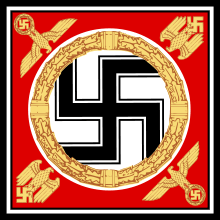 | 1935–1945 | Standard of Adolf Hitler | |
 | 1935–1938 | Flag of the Wehrmacht Commander in Chief (replaced the Minister of Defence) | |
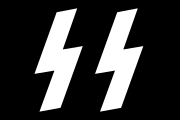 | 1935–1945 | Flag of the Schutzstaffel (SS) | |
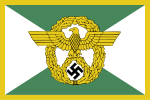 | 1936–1945 | Flag of the Ordnungspolizei (OrPo) ("Order Police", the national regular police organization of Nazi Germany) | |
|
| Flag | Date | Use | Description |
.svg.png) | 1946–1950 | "C-Pennant" (C-Doppelstander) (provisional civil ensign) | Used during the Occupation Period to identify German ships according to international law. |
| Flag | Date | Use | Description |
 | 1949–1959 | State flag (Staatsflagge) | |
 | 1959–1990 | State flag (Staatsflagge) 1959–1990
Merchant flag (Handelsflagge) 1973–1990 | Tricolour of black, red, and yellow (same as West German colours), but bears the coat of arms of East Germany, consisting of a compass and a hammer encircled with rye |
 | 1959–1973 | Merchant flag (Handelsflagge) | |
.svg.png) | 1963–1990 | Hanging state flag (Bannerflagge) | |
.svg.png) | 1955–1973 | Flag of East German Post | |
.svg.png) | 1975–1990 | Flag of East German Post | |
 | 1955–1990 | Standard of the President | |
 | 1960–1990 | Standard of President of State Council | |
.svg.png) | 1960–1990 | Flag of the National People's Army (Nationale Volksarmee or NVA) | |
.svg.png) | 1960–1990 | Regimental colours (Truppenfahne) of Nationale Volksarmee | |
.svg.png) | 1960–1990 | Naval ensign (Seekriegsflagge) | |
.svg.png) | 1962–1990 | Flag of boats of border troops | |
 | 1989–1990 | Defaced state flag | Used by supporters of German reunification in East Germany after the fall of the Berlin Wall. |
Historic flag proposals
Notes
References
|
|---|
|
|
|
| State-related | |
|---|
|
| Other entities | |
|---|
|
| By design | |
|---|
|
| By nations | |
|---|
|
| By continent | |
|---|
|
Names in italics indicate non-sovereign (dependent) territories, disputed states and/or former countries. |

.svg.png)
.svg.png)




.svg.png)



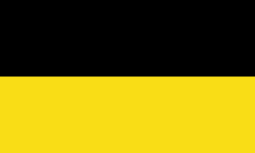
.svg.png)
.svg.png)


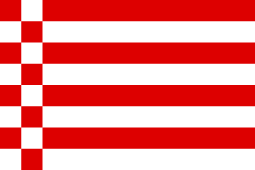
.svg.png)

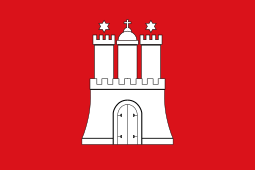

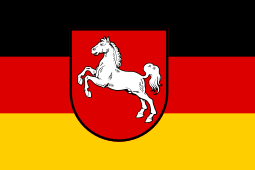
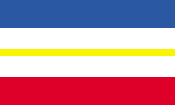



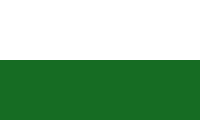


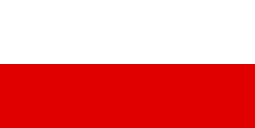
.svg.png)
.svg.png)
.svg.png)
.svg.png)
.svg.png)

.svg.png)



.svg.png)

.svg.png)
.svg.png)
.svg.png)


.svg.png)
.svg.png)
.svg.png)
.svg.png)
.svg.png)
.svg.png)



.svg.png)

.svg.png)



.svg.png)
.svg.png)


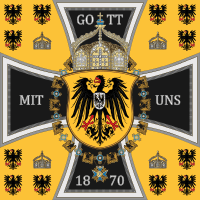




.svg.png)
.svg.png)
.svg.png)
.svg.png)
.svg.png)

.svg.png)
.svg.png)
.svg.png)


.svg.png)
.svg.png)
.svg.png)

.svg.png)
.svg.png)






.svg.png)
.svg.png)



.svg.png)





.svg.png)



.svg.png)
.svg.png)
.svg.png)


.svg.png)
.svg.png)
.svg.png)
.svg.png)






